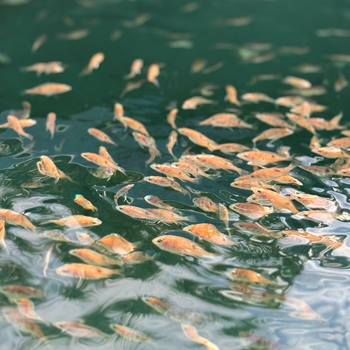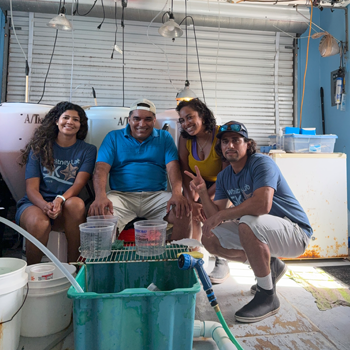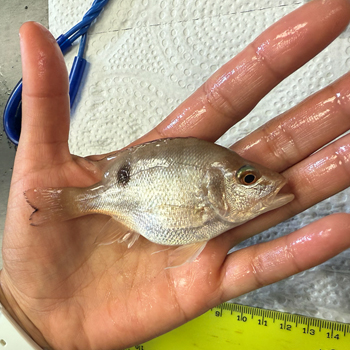
By: Geresa-Leigh Luke
Aquaculture has been described as the “world’s fastest growing food sector” (FAO), playing a critical role in blue economy development and, most importantly, food security. Scientists have long warned that overfishing in the commercial fishing industry is causing irreparable damage to natural populations and ecosystems, a problem further intensified by warming oceans. Many experts suggest that sustainably farmed seafood is one of the most promising solutions to this challenge.
Regional Context: CARICOM and Food Security
The Caribbean Community (CARICOM), an alliance of 21 countries founded in 1973 by Barbados, Jamaica, Guyana, and Trinidad and Tobago, seeks to strengthen economic integration, foreign policy coordination, social development, and regional security. Food security has been identified as one of its most urgent priorities.
The 25 by 2025 Initiative was launched to reduce the region’s food import bill by more than $6 billion and stimulate local agricultural production. It aims to “tackle the Region’s rising food import bill, improve intra-regional trade, and create wealth and economic opportunity for every CARICOM Member State.” As of February 2025, the initiative has been extended to 2030.
FAO’s Role in Jamaica
The Food and Agriculture Organization of the United Nations (FAO) is a specialized agency that “leads international efforts to defeat hunger and improve nutrition and food security” (FAO). In Jamaica, FAO has begun developing a mariculture pilot program to strengthen agricultural resilience. Currently, aquaculture in Jamaica—like much of the Caribbean—focuses on tilapia, freshwater shrimp, and ornamental fish. Marine finfish aquaculture, however, is still emerging, as it presents complex challenges.
Two species have been identified as particularly promising for this program: Red Snapper (Lutjanus campechanus) and Red Drum (Sciaenops ocellatus), both of which are commercially important in Florida and throughout the Gulf of Mexico and represent key candidates for aquaculture diversification. To support this effort, FAO enlisted the help of Dr. Leonardo Ibarra-Castro of the University of Florida Whitney Laboratory for Marine Bioscience in 2024. With more than 20 years of aquaculture experience across Latin America, Asia, and the Caribbean, Dr. Ibarra-Castro has spent the past six years optimizing pilot-scale hatchery systems for marine finfish while integrating high-quality research.
Technology Transfer and Pilot-Scale Production
Dr. Ibarra-Castro emphasizes that effective technology transfer in aquaculture depends on work at the pilot scale rather than in experimental settings.
“The pilot scale is where larval rearing processes are integrated, unnecessary costs are eliminated, and technical and economic efficiency is ensured,” he explains. “Skipping this stage has led to global failures in attempts to commercialize technologies without real support. The pilot scale represents the phase in which technology reaches maturity, integration, and harmony among all its productive components. This is where mass production processes are perfected, unnecessary elements that increase the cost of the operation are eliminated, and innovations are introduced that guarantee efficiency and sustainability. The goal is to achieve consistency, with solid technical and economic foundations, for transfer to producers and communities. Red snapper juvenile production at the Whitney Lab has advanced to this scale because it is the natural bridge that connects experimental science with the sustainable and competitive production demanded by the regional and international aquaculture sector.”
At the Whitney Lab, Dr. Ibarra-Castro’s team operates a 25 m² semi-automatic hatchery, where they culture live zooplankton feeds and rear larvae. The facility also houses broodstock of five marine finfish species, including Red Snapper and Red Drum (Figure 1).
Who's hungry? Our snapper sure are! 😋🐟#whitneyaquaculture #aquacultureresearch #whitneylab #aquaculture #redsnapper #sustainableseafood #universityofflorida #ufl #marinescience #fisheriesscience pic.twitter.com/lVkvGBJIb2
— Whitney Aquaculture (@whitaquaculture) September 3, 2025
Found from Cape Cod to Mexico, this bottom-feeder is a key player in NE Florida estuaries. It prowls seagrass, reefs & nearshore waters, feeding on fish & crustaceans. Its dark spot may trick predators into striking the wrong end—one of its most iconic features. #reddrum pic.twitter.com/EkakucxaQD
— Whitney Aquaculture (@whitaquaculture) September 3, 2025
Figure 1: Whitney laboratory broodstock - Red snapper (Lutjanus campechanus) and Red drum (Sciaenops ocellatus)
Breaking Barriers with Red Snapper
Red snapper are notoriously difficult to culture successfully. Their larvae are highly sensitive to environmental conditions, and the timing of first feeding is critical to survival.
Following three years without spawning success, a long-awaited breakthrough occurred in April 2025. For the first time, Dr. Ibarra-Castro’s broodstock began producing Red Snapper eggs (Figure 2).
BIG NEWS! After 3 years of hard work, our red snapper are spawning! 🐟 This breakthrough marks a major step for sustainable aquaculture. We’re now focused on larval rearing to ensure strong survival & grow-out success—each spawn moves us closer to responsible seafood. pic.twitter.com/JeRkCh8nLX
— Whitney Aquaculture (@whitaquaculture) September 3, 2025
Figure 2: Spawning Announcement
The team carefully prepared and monitored the eggs as they developed into larvae (Figure 3).
Look closely 👀—this 5-day-old red snapper larva already has a beating heart, liver & circulatory system! By studying these fragile early stages, we can better understand larval biology & refine hatchery practices for sustainable aquaculture. pic.twitter.com/yeYGUYuxkI
— Whitney Aquaculture (@whitaquaculture) September 3, 2025
Figure 3. A 5-day old larval video
Yet after several unsuccessful spawning cycles, survival still seemed elusive. At the end of the spawning season, however—when expectations were low—the larvae surpassed their usual point of mortality. Three days post-hatch, they began feeding and soon after metamorphosed into juvenile fish (Figure 4).
Breaking news: we have juvenile red snapper! 🐟 After weeks of care, our larvae are now weaning—transitioning from live Artemia to pellet feeds, a big step toward independence & grow-out success. Their iconic red color is still developing—stay tuned for our Snapper Series! pic.twitter.com/14vdSo5AfV
— Whitney Aquaculture (@whitaquaculture) September 3, 2025
Technician Geresa-Leigh Luke recalls: “I remember how anxious we all were, checking every single day, waiting to see if the snapper would live. Finally, on our harvest day a month later, when we transferred the juveniles to the larger grow-out tank, the energy was electric. We were celebrating while working, playing music and dancing, just so relieved the snapper had survived!” (Figure 5 a-c).

Figure 5a-c. Harvest day at the Whitney Lab; the Ibarra-Castro lab transferred the newly metamorphosized juvenile snapper from their hatchery to the grow-out tank in July 2025. A. (Left to right) PhD student Karen Carvajal-Soriano, Dr. Leonardo Ibarra-Castro, technician Geresa-Leigh Luke, and visiting scholar PhD student Josue López-Cardiel. B/C. Carvajal-Soriano and Luke transferring juveniles to the grow-out tank.
Over the following weeks, the team observed remarkable growth and behavior. “The snapper's behavior is so different to what we’ve seen in other species,” says Karen Carvajal-Soriano, Ph.D. student. “They are so curious, and during maintenance they swim right up to you—sometimes even nibbling at your legs and feet!” Luke adds: “It was a joy to watch their iconic red color develop and see them get bigger, more voracious at feeding, even noticing their irises turn red (Figure 6).”
 \
\
Figure 6. Measuring a two-month-old juvenile red snapper to track growth and biometric trends.
Expanding to Jamaica
On August 20, 2025, approximately 3,000 juvenile snapper from the Whitney Laboratory were transported overnight to Port Royal, Jamaica (Figure 8). Veterinary staff reported that the fish appeared strong and resilient, acclimating quickly to their new tanks and feeding eagerly.
Dr. Ibarra-Castro sees this as just the beginning. “Our next goal is to develop a pilot-scale hatchery on the ground in Jamaica, similar to what we have at Whitney Lab. It is not an easy process, but with the right teaching, instruction, and plenty of practice over time, we believe this can benefit Jamaica’s efforts to build a stronger and more secure aquaculture industry. We are quite excited to see how this project develops in the coming years.”
Acknowledgments
The Ibarra-Castro Lab extends heartfelt gratitude to everyone who contributed to this long and labor-intensive process. “We are especially thankful to visiting scholar Josue López-Cardiel, whose dedication alongside Dr. Ibarra-Castro was vital to the larval rearing process, and to UF’s aquatic veterinary experts—Dr. Ruth Floyd, Dr. Roy Yanong, and Debbie Pouder—for their dedicated guidance and clinical expertise. We are sincerely grateful to the representatives at FAO for inviting us to collaborate on this project and for providing the support that made it possible.”
We’re truly grateful to have collaborated with @FAOCaribbean on this exciting new endeavor—we can’t wait to see how this project unfolds! https://t.co/qgFacqmom6
— Whitney Aquaculture (@whitaquaculture) September 11, 2025
Figure 7. FAO’s (Caribbean) post about the snapper arrival in Jamaica
Stay connected with the Whitney Lab Aquaculture team on X (@whitaquaculture) and Instagram (@whitneyaquaculture) for the latest updates on our research and projects.
Citations: